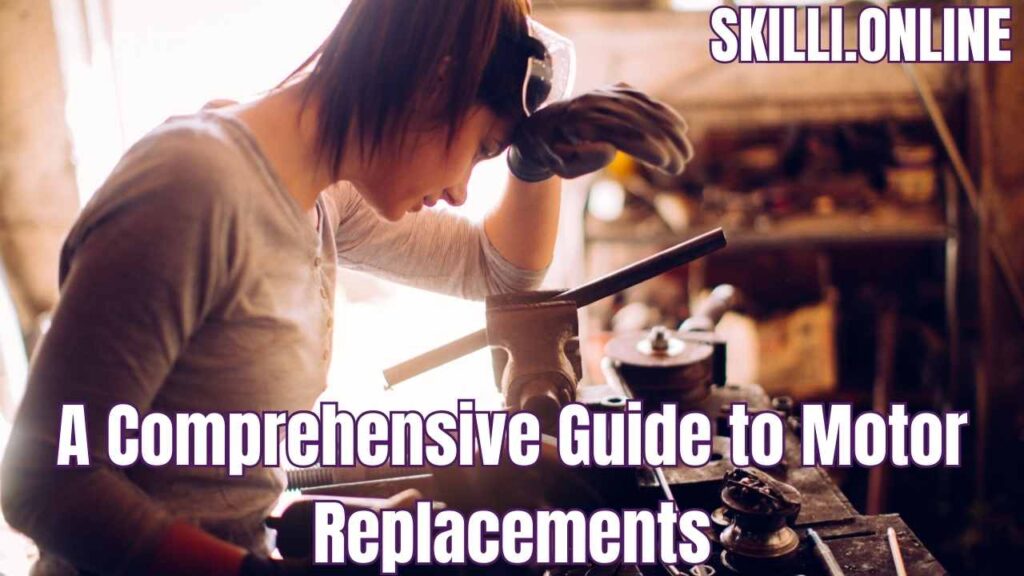A 1st Comprehensive Guide to Motor Replacements

Motor Replacements When it comes to machinery and appliances, motors are the heart and soul, providing the power to make things work. However, like any other mechanical component, motors can wear out over time, leading to decreased efficiency or complete failure. In such cases, motor replacement becomes essential. This article will guide you through the key aspects of motor replacements, from recognizing the signs of a failing motor to the steps involved in replacing it.
Table of Contents
Recognizing the Signs of a Failing Motor
Before delving into the Motor Replacements process, it’s crucial to identify when your motor might be on the brink of failure.
Excessive Noise: Motors should operate quietly. If you notice unusual sounds like grinding, squeaking, or knocking, it could indicate internal issues.
Overheating: Motors that overheat frequently are likely to fail soon. Check for excessive heat emanating from the motor or burning smells.
Reduced Performance: If your machine or appliance isn’t operating as efficiently as before, it might be due to a failing motor. This includes slower speeds, weaker power output, or irregular movements.
Frequent Tripping: Motors drawing too much current can lead to circuit breakers tripping. If this happens frequently, it’s a sign of motor problems.
Visible Damage: Inspect the motor for physical damage such as corrosion, rust, or burnt wires. Such damage often necessitates replacement.
Choosing the Right Replacement Motor
Once you’ve confirmed that a replacement is needed, the next step is choosing the right motor. Consider the following factors:
Motor Type: Determine the type of motor you need, such as AC, DC, or synchronous, based on the application.
Size and Power: Select a replacement motor with the same or compatible size and power specifications as the old one.
Efficiency: opt for a motor that offers better energy efficiency to reduce operational costs.
Brand and Quality: Invest in a reputable brand for reliability and longevity.
The Replacement Process
Now, let’s walk through the steps involved in replacing a motor:
Safety First: Always disconnect the power source and follow safety procedures when working with motors.
Access and Removal: Open the appliance or machinery to access the old motor. Remove it carefully, taking note of the wiring and connections.
Wiring: Connect the new motor following the manufacturer’s wiring diagram. Ensure all connections are secure.
Testing: Before closing everything up, perform a test run to ensure the new motor is functioning correctly.
Maintenance: Regularly check and maintain your replacement motor to prolong its lifespan.
Ideal Time Period For Motor Replacements of Different Parts

Certainly, understanding the ideal time period for motor Replacements is crucial to prevent unexpected failures and downtime. However, the replacement frequency can vary widely depending on several factors, including the type of motor, its usage, maintenance, and environmental conditions. Here are some general guidelines for common types of motors:
1. HVAC Motors:
Ideal Replacement Time: HVAC motors, like those in air conditioning and heating systems, typically last around 10 to 15 years with proper maintenance.
Maintenance: Regular cleaning, lubrication, and belt replacement can extend the life of HVAC motors.
2. Electric Motors in Appliances:
Ideal Replacement Time: Electric motors in household appliances such as washing machines, dishwashers, and refrigerators can last anywhere from 10 to 20 years or more.
Maintenance: Regularly clean the appliance’s vents and ensure it’s level to reduce strain on the motor.
3. Industrial Motors:
Ideal Replacement Time: Industrial motors vary widely in lifespan based on their size and usage. Smaller motors might last 10 to 20 years, while larger ones can last several decades.
Maintenance: Regular maintenance, including cleaning, lubrication, and vibration analysis, can significantly extend the life of industrial motors
4. Automotive Motors:
Ideal Replacement Time: The lifespan of automotive motors depends on various factors, but a well-maintained car engine can last for over 200,000 miles or 15-20 years.
Maintenance: Regular oil changes, proper cooling system maintenance, and addressing any unusual sounds or issues promptly can extend the life of automotive motors.
5. DC Motors (e.g., in electric vehicles):
Ideal Replacement Time: DC motors in electric vehicles have a longer lifespan than internal combustion engines. With proper care, they can last over 100,000 miles or more.
Maintenance: Regularly check the condition of the battery pack and ensure it’s maintained within recommended parameters to extend the life of DC motors.
6. Pool Pump Motors:
Ideal Replacement Time: Pool pump motors typically last around 8 to 12 years with regular use and maintenance.
Maintenance: Regularly clean the pool filter, ensure proper water chemistry, and lubricate motor bearings as needed.
The key to extending the life of any motor is routine maintenance, which includes checking for signs of wear, addressing issues promptly, and following manufacturer-recommended service intervals. Additionally, motors that operate in harsh environments, such as extreme temperatures or high humidity, may require more frequent replacements or maintenance. Always consult the manufacturer’s recommendations and consider seeking professional advice for specific motor replacement timelines.
Conclusion
Motor replacements are a crucial aspect of maintaining the functionality of various appliances and machinery. By recognizing the signs of a failing motor, choosing the right replacement, and following the proper replacement process, you can ensure the smooth operation of your equipment. Remember that safety should always be a top priority when working with motors. If you’re unsure about the replacement process, consider consulting a professional technician to avoid any mishaps.